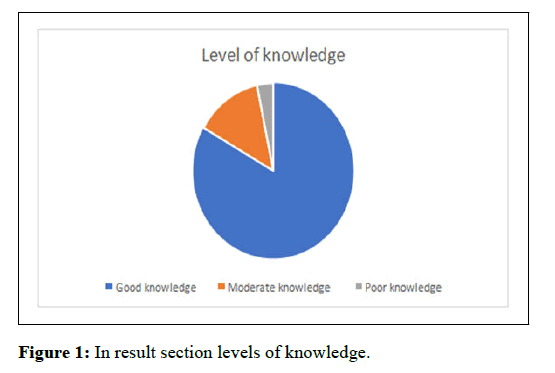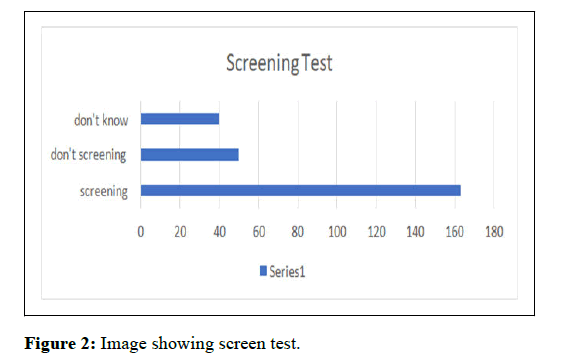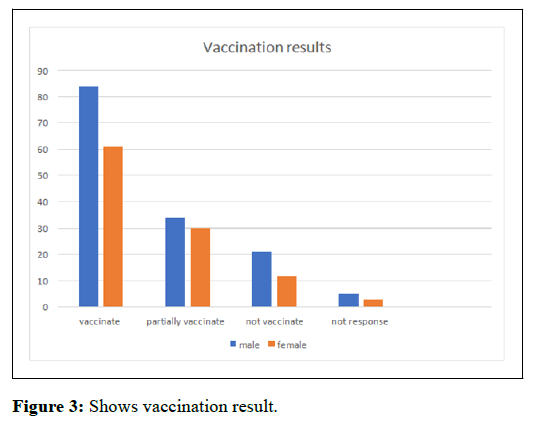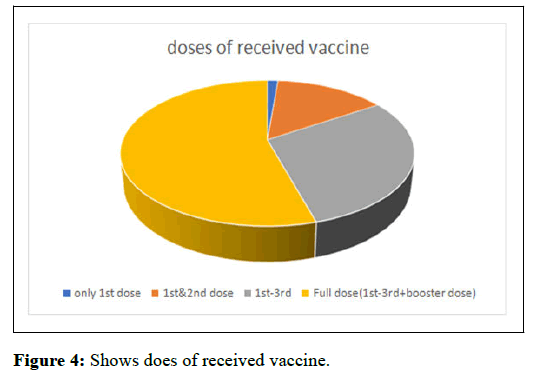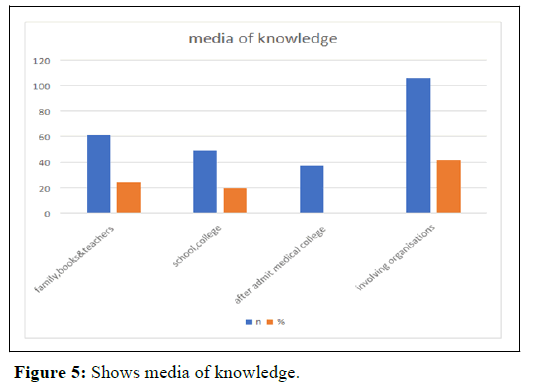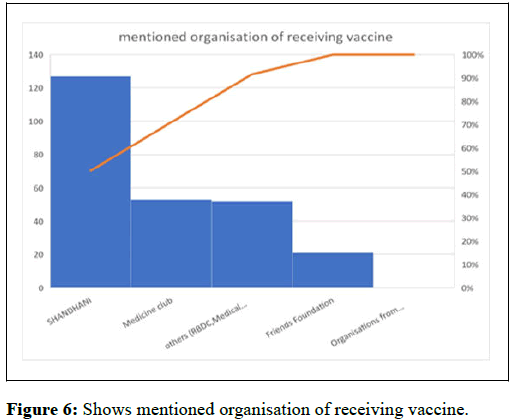A Cross Sectional Study on Knowledge about HBV Vaccination among the Medical Students of a Tertiary Medical College and Organizations Involved In Vaccination and Awareness
Received: 13-Aug-2020 / Manuscript No. JIDT-20-17326 / Editor assigned: 18-Aug-2020 / PreQC No. JIDT-20-17326(PQ) / Reviewed: 01-Sep-2020 / QC No. JIDT-20-17326 / Revised: 30-Nov-2022 / Manuscript No. JIDT-20-17326 / Published Date: 28-Dec-2022 QI No. / JIDT-20-17326
Abstract
Objectives: The study was done to know about the knowledge about Hepatitis B infection and develop awareness among the students to receive vaccine.
Methods: A cross sectional study was conducted among the medical students of northern Bangladesh in January, 2020 using a pretested self administrated structured questionnaire. Chi-square (X2) test was used to compare between different variables to identify significance level.
Results: Total 253 medical students from a tertiary thousands bed medical college under MBBS and BDS curriculum, among them 50.99% was male and 40.01% was female and 47.82% was from town and 52.17% was from village. From all participants 57.31% was vaccinated with full dose completed, 26.29% did not complete dose (Booster dose) and 13.44% never received vaccine, from the unvaccinated persons 16.33% did not know about the organizations from where vaccine is received and who knew about the organization form where vaccine can take, more than 90% mentioned the name of shandhani (A free blood donating and vaccination organizations). Along with HBV vaccination 53.78% could mention that they also completed EPI schedule, 20.32% could not remember and 23.9% did not complete EPI. Before taking vaccine 64.94% was go through screening procedure and 15.54% did not know about screening.
Conclusion: From our study we can say that we need more awareness for taking vaccine and government should include HBV in EPI schedule. And also need to organize awareness program or campaign among the community people and students of all sectors to increase knowledge.
Keywords: Hepatitis; Vaccination; Vaccine; Medical students; Booster dose
Keywords
Hepatitis; Vaccination; Vaccine; Medical students; Booster dose
Introduction
Viral hepatitis is a significant disease afflicting hundreds of millions of people. Hepatitis-causing viruses initiate significant morbidity and mortality by establishing both acute and chronic infections, and several of these viruses are specifically associated with the development of Hepatocellular Carcinoma (HCC).
Consequently, intense research efforts are focused on increasing our understanding of virus biology and on improving antiviral therapy [1]. Even though viral hepatitis can be caused by several viruses from a range of virus families, the discovery of components of the Hepatitis B Virus (HBV) became a catalyst for the development of diagnostic assays that differentiate between these viruses as well as strategies for novel methods of vaccine development [2]. Improvements in both the treatment and prevention of viral hepatitis are advancing rapidly. However, HBV, along with the associated infection by the hepatitis D virus, is still among the most common pathogens afflicting humans [3]. Hepatitis B is one of the most common infectious diseases in the world. It has been estimated that 350 million people worldwide are chronic Hepatitis B Virus (HBV) carriers. The global prevalence of chronic HBV infection varies widely, from high (>8%, e.g., Africa, Asia and the Western Pacific) to intermediate (2%-7% e.g., Southern and Eastern Europe) and low (<2%, e.g., Western Europe, North America and Australia) [4]. The predominant routes of transmission vary according to the endemicity of the HBV infection. In areas of high endemicity, perinatal transmission is the main route of transmission, whereas in areas of low endemicity, sexual contact amongst high risk adults is predominant. Between one third and one quarter of people infected chronically with HBV are expected to develop progressive liver disease (including cirrhosis and primary liver cancer) [5]. Although mass vaccination programs have begun to control the spread of HBV infection, therapeutic intervention is the only option for those with established chronic HBV-associated liver disease. Until recently, the only treatment for chronic hepatitis b was the immune modulator, Interferon (IFN) alpha [6]. However, IFN alpha treatment has several disadvantages; it is expensive, it must be administered by injection, there are side-effects, and IFN alpha is poorly tolerated. Lamivudine, a nucleoside analogue, is the first effective, and well tolerated, oral treatment for chronic hepatitis b in conclusion, although we are still some way from eradicating or curing chronic hepatitis b, the advent of lamivudine allows new populations to benefit from therapy and helps to address the global public health problem of hepatitis b Bangladesh, together with the Indian sub-continent, is recognized as a country with moderate prevalence of hepatitis [7].
B beyond this rather surface-level characterization, there remains considerable ambiguity regarding the epidemiology of Hepatitis B Virus (HBV) infection in the country. Lack of reliable epidemiological information has been cited as one of the key challenges to effective hepatitis B response in bangladesh and yet, a substantial number of studies on HBV prevalence in Bangladesh has indeed been conducted since the early 1980’s in this context, there is a need for a comprehensive analysis of the findings of these studies which would guide both future research and policy [8]. The present review aims to address this gap. In order to characterize the review with a sharp focus, we sought to confine ourselves to a few key questions regarding HBV prevalence in bangladesh first, has enough epidemiological data been generated to draw precise, quantitative estimates about the prevalence of HBV in Bangladesh? Second, what do the studies targeting particular [9]. Population groups tell us about the specific modalities of HBV transmission-for example, the extent to which vertical transmission is important in the spread of HBV, or vulnerabilities of particular risk groups? third, what do we know about the distribution of HBV genotypes in bangladesh? answers to these questions are often nebulous and require substantial qualification, which necessitates a commentary on the general trends characterizing HBV epidemiology research in Bangladesh in the last decades [10]. Based on these trends, we also provide suggestions as to the direction of future HBV research in bangladesh the present article does not aim to be a systematic review. However, the analysis presented here is hoped to be comprehensive enough to serve as an update to current HBV epidemiology in Bangladesh. The present article does not aim to be a systematic review. However, the analysis presented here is hoped to be comprehensive enough to serve as an update to current HBV epidemiology in Bangladesh [11].
Materials and Methods
Study design and setting area of study
A cross-sectional study was conducted among 253 students of rangpur medical college of five current batches. All current batches participated during data collection. A self-administrated pretested questionnaire was provided [12].
Sampling techniques and sample size
A single population proportion formula was used to estimate sample size. By considering 95% confidence level with Z value of 1.96 with a 5% margin error the sample size is measured. By calculation the ideal sample size was 384 and due to vacation of few current batches we could manage 253 participants [13].
Data collection variables and measurements
Data was collected by pre-tested self-administrated questionnaire. The validity and reliability of the questionnaire was tested through a cross-sectional study and discussed with public health and internal medicine experts. Then 20 students from 4th and 5th year students were randomly selected to explore if there was any ambiguity or presence of any misunderstanding in the questionnaire to reach the final form of it. There are few variables and they are age, gender, study year, residence [14]. Age group was divided into three categories and they are a age group of 18-20 years of age, 21-23 years of age and above 23 years of age group. Study year was considered as all current batches like first-fifth year and covered age groups. Male and female two groups of gender and residence was mainly considered as their academic and non-academic residence like two groups who recently stay at home with family is non-academic residence and who stay in campus residence is considered as academic residence thus we can compare the knowledge level who knew about hepatitis after coming medical college and received vaccine [15].
Investigations of knowledge level
Identification of knowledge about hepatitis and hepatitis b virus infection was determined by their answer on some questions we frequently asked them about Hepatitis-b infection. The questions included about hepatitis b mode of transmission, mode of contamination, screening procedure, total dose and duration [16]. Total ten questions were included in the questionnaire. All the questions were true or false based and whom answered correctly got 1marks and for incorrect answer no point was given. According to their answer we determined their knowledge as who correctly answered 7-10/10 is considered as good knowledge, correctly answered 5-6/10 considered as moderate knowledge and below 5 correctly answered from total 10 are considered as poor in knowledge about hepatitis. In result section level of knowledge is presented by a pie chart which is shown on (Table 1) [17].
| Variables | N | % | P |
|---|---|---|---|
| Male | 129 | 50.99 | - |
| Female | 124 | 40.01 | |
| Hostel (institutional) | 217 | 86 | 0.083 |
| With family | 36 | 14 | |
| Others | 0 | 0 | |
| Town | 121 | 48.82 | 0.021 |
| Outside the town | 132 | 52.17 | |
| Outside the country | 0 | 0 | |
| 18-20 | 93 | 36.75 | 0.582 |
| 21-23 | 102 | 40.71 | |
| >23 | 58 | 22.29 | |
| First professional | 141 | 55.57 | 0.001 |
| Second professional | 13 | 0.05 | |
| Third professional | 11 | 0.04 | |
| Final professional | 71 | 28.06 | |
| Internship | 17 | 0.06 | |
| <20,000 | 21 | 8.3 | 0.092 |
| 20,000-40,000 | 152 | 60.07 | |
| >40,000 | 80 | 31.62 | |
Table 1: Different variables of the health science students.
Doses of vaccine received and reason of not received
In case of Hepatitis B virus vaccine have total four doses, One is initial dose after screening and then second, third dose should take after one and two month interval of initial dose. Last dose or fourth dose should take one year after initial dose which called Booster dose [18]. Who already received and receiving vaccine we collected the information which was included as a chart of doses of vaccine and calculated the total number of doses they received (Table 2).
Response |
Vaccinated (n, %) |
Partially (n, %) |
P value |
|
|---|---|---|---|---|
| The easiest way to get hepatitis B through sharing equipment to inject drugs. | Correct | 71,48.96 | 58,53.7 50,46.2 | 0.9 |
| Incorrect | 74,51.03 | 9 | ||
| The majority of people with chronic hepatitis B do not have any symptoms. | Correct | 95,65.51 | 84,77.7 | 0.011 |
| Incorrect | 50,34.48 | 24,22.2 92,85.1 | ||
| There is medication to treat hepatitis B | Correct | 125,86.21 | 16,14.8 78,72.2 | 0.832 |
| Incorrect | 20,13.79 | |||
| Hepatitis B can be transmitted by air. | Correct | 134,92.41 | 30,27.7 | 0.087 |
| Incorrect | 11,7.58 | |||
| Everybody with a positive hepatitis B antibody test has chronic hepatitis B disease (infection). | Correct | 84,57.93 | 77,71.29 31,28.7 68,62 | 0.872 |
| Incorrect | 61,42.06 | |||
| There is a vaccine for hepatitis B | Correct | 93,64.37 | 40,37.03 | 0.214 |
| Incorrect | 52,35.86 | |||
| People who clear the hepatitis B virus, either spontaneously or after medical treatment can be infected again. | Correct | 79,54.48 | 83,76.8 5 25,23.1 101,93. | 0.007 |
| Incorrect | 66,45.51 | |||
| Hepatitis B vaccine has total 4 doses. | Correct | 115,79.31 | 7,6.48 99,91.6 | 0.01 |
| Incorrect | 30,20.68 | |||
| Booster dose is initial dose of hepatitis B | Correct | 101,69.65 | 6 9,8.33 | 0.08 |
| Incorrect | 44,30.34 | |||
| Hepatitis B can be transmitted by syringe, blade, during receiving blood, by cutting sharp objects. | Correct | 83,57.24 | 71,65.74 37,34.25 | 0.03 |
| Incorrect | 62,42.75 |
Table 2: Hepatitis B virus vaccine of different values.
Statistical analysis
Statistical analysis was done by both SPSS version 20.0 and Microsoft Excel 2007 version. Microsoft excel version 2013 was used to entry data and SPSS version 20 used to analysis data. Chi square (X2) test was. Done to compare the responses, if p value shows <0.05 it was considered as significant result of the variable [19].
Ethical and administrative consideration
• A formal approval was taken from research ethics of community medicine department of rangpur medical college.
• A formal ethical clearance was taken from the principle of rangpur medical college.
• A formal ethical clearance was taken from Rangpur Medical College Hospital (RpMCH).
Results and Discussion
Total 253 participant were participated in this study and from them male (n=129; 50.99%) and female (n=124; 50.99%) and significance level, p=0.1 According to present residence n=217 (86%) stay in hostel(institutional residence) and 36 (14%) stay with their family, here significance level of p=0.83 Age group was divided into three categories, from 18-20 age group here n=93 in number (36.75%) age group of 21-23 here n=102 in (40.32%) age group above 23years here n=58 (22.29%), in case of significance level among different age group here p=0.21 which is <0.05 and shows a significant relation [20]. Total five current academic batches and intern students were participated and maximum number of interest group was from 1st, 2 nd and 5th year students, here from 1st and 2nd year students n=141 (55.57%), 3rd year students n=13 (0.05%), 4th year students n=11 (0.04%), 5th year students n=71 (28.06%) and intern doctors n=17 (0.06%) and significance level of p=0.001 which shows a significance result, demographic information are presented in Table 1. According to the response of questions on Hepatitis b transmission the knowledge level about Hepatitis-B virus considered as good knowledge, n=204 (81%), moderate knowledge, n=36 (14%) poor knowledge, n=13 (5%), result of knowledge about hepatitis B infection, transmission, vaccination is presented in the Table 2 by a pie chart in Figure 1.
Screening is a most important things to confirm about presence or absence of Hepatitis B in a human body. We frequently asked them about screening who already received vaccine because before taking vaccine screening have to done. People who did screening before receiving vaccine, did screening, n=163 (64.43%) did not go through screening but received vaccine, n=90 (19.76%), it is present in Figure 2.
From total participants Vaccinated are n=145 (57.31%) and they have completed all four doses, partially vaccinate or receiving vaccine or yet not completed all four doses are n=66 (26.09%) and people who do not received any dose, n=34 (13.44%), result of vaccination shown in Figures 3 and 4.
There were many organizations involved in making awareness among the medical students about infectious diseases and encouraging to receive vaccine in time, result of organizations involved in making awareness and vaccination program without profit are presented by histogram and shown on Figure 5.
We found many names such as shandhani, medicine club, friends foundation, red crescent, rbdc and many more. From them all maximum participants mentioned the name of organization from where received vaccine, it was shandhani and which is a non profit blood donating organization also involved in some vaccination program. media from where they knew about hepatitis-b and vaccination they mentioned from family, school, social media, campaign program, television and many more. Result of media is shown in Figure 6.
Hepatitis B infection, is a global problem and middle and low socioeconomic country of the world are suffering from this in current situation. Vaccination awareness is low in this countries. And now a days, it shows a public health demand to make awareness, build knowledge among the people about hepatitis and also make vaccine available to every people over the world. The study was done to find out the knowledge about hepatitis b and importance of receive vaccine within appropriate age [21]. Although there is no age limit to take vaccine but it is wise to take vaccine as early possible. We did a survey among the medical students of a tertiary medical college of northern bangladesh. The survey was done on the medical students because. Hepatitis is a medical term and it is must that sincere level should be significant in health science students. Vaccination awareness also be expected higher in this sector than we can compare the knowledge level and awareness of receiving vaccination percentage to other faculties in future study [22]. We compared the knowledge level among different variables of the health science students. The aim of this study was to know about the knowledge of the students about Hepatitis b transmission and disease awareness. We found a significant result or response from the students who already have a good knowledge and very few who have moderate or poor knowledge, our aim is to make more scope to make them interested to know about hepatitis b this step to provide a good knowledge we can start from institutions by arranging monthly seminar or by campaign.
Another aim of our study was to aware the students to receive vaccine and complete all doses in time. Here we also found a significant result of receiving vaccine but poor response in completing full doses. We found from investigation that who received all four doses or who are complete vaccinated, n=145 (57.31%) we can say that more than half are well vaccinated or completely vaccinated. Partially or who did not completed all doses (some have one or two or three doses of complete) n=66 (26.09%) so, we have to make aware that completing doses are very important. If someone don’t received all the doses and it goes for many years they have chance for viral attack of hepatitis b so, have to make awareness among the students about importance of final or booster dose. From this study we can make a decision that the institutions should make all the students aware to receive vaccine in mean time and also check the vaccination progress. Knowledge and awareness about screening before receiving vaccine to for confirmation and pre-vaccination treatment was a important part of this study because screening is a very necessary part before receive vaccine because already infected person of hepatitis b can not get cure from the vaccine and he need to pre-vaccination preparation and treatment to be ready for proper vaccination outcome. So, we need to make awareness about pre-vaccination task or screening before decided to receive vaccine [23]. We also tried to know about the vital media form where they knew about hepatitis-b and importance of vaccination and we found different media such as television, radio, newspaper, social media, campaign, form family members and institutions. In case of medical students. Maximum of them have knowledge about hepatitis-b from secondary school level and they received vaccine before coming medical college and that also a great news that they have awareness from very early stage of education life. So, we need to make aware among them about screening. We included in our survey the organizations that doing a great job in making awareness about vaccination program among medical students and others. Because this institutions are playing a vital role in vaccination awareness and encouraging to receive vaccine in time and in available cost. We think we should do more investigation and awareness outside of health science students and make more campaigns on vaccination to prevent people form hepatitis.
Conclusion
The aim of this study was to make awareness for taking Hepatitis-B virus vaccine immediately to the health professionals and the students also. Because we know this virus can enter our body by blood and medical students when go to ward and sometimes they may injured by used needles, blades and can easily infected. So, it’s very important to them to take vaccine to prevent themselves from hepatitis. The hepatitis B vaccine is the mainstay of hepatitis B prevention. WHO recommends that all infants receive the hepatitis B vaccine as soon as possible after birth, preferably within 24 hours-followed by two or three doses of hepatitis B vaccine at least four weeks apart to complete the series. Timely birth dose is an effective measure to reduce transmission from mother-to-child. According to latest WHO estimates, the proportion of children under five years of age chronically infected with HBV dropped to just under 1% in 2019 down from around 5% in the pre-vaccine era ranging from the 1980's to the early 2000's. This marks the achievement of one of the milestone targets to eliminate viral hepatitis in the Sustainable Development Goals to reach under 1% prevalence of HBV infections in children under five years of age by 2020.
Acknowledgement
The author would be thankful to Dr. A K M Nurunabi Laizu, Principle and Head of the department of Skin and VD, Rangpur Medical College, Rangpur. Dr. Nurun Nabi (pediatrics), Dr. Sarwer Jahan (medicine). Dr. Tasfia Tasbih (RA, Montreal Behavioural Medicine Center), Dr. ahirul Islam (TA,University of Louisiana), Dr. Homyra Siddik (RA, University of Louisiana).
References
- Eke AC, Eleje GU, Eke UA, Xia Y, Liu J, et al. (2017) Hepatitis B immunoglobulin during pregnancy for prevention of mother‐to‐child transmission of hepatitis B virus. Coch Data of Sys Rev 2.
[Googlescholar] [Indexed]
- Byington Carrie L, Yvonne A, Maldonado, Elizabeth D, Barnett James D, et al. (2017) Elimination of perinatal hepatitis B: providing the first vaccine dose within 24 hours of birth. Pediatrics 140: 1-3.
[Crossref] [Googlescholar] [Indexed]
- Centers for Disease Control and Prevention (CDC, 2011). Use of hepatitis B vaccination for adults with diabetes mellitus: Recommendations of the advisory committee on immunization practices. Morb Mort Rep 60: 1709-1711.
[Crossref] [Googlescholar] [Indexed]
- Bar On ES, Goldberg E, Hellmann S, Leibovici L (2012) Combined DTP‐HBV‐HIB vaccine versus separately administered DTP‐HBV and HIB vaccines for primary prevention of diphtheria, tetanus, pertussis, hepatitis B and Haemophilus Influenzae B (HIB). Coch Data Sys Rev 4.
[Crossref] [Googlescholar] [Indexed]
- Centers for Disease Control and Prevention (CDC, 2003) FDA licensure of diphtheria and tetanus toxoids and acellular pertussis adsorbed, hepatitis B (recombinant), and poliovirus vaccine combined, (pediarix) for use in infants. Morb Mortal Wkly Rep 52: 203-204.
[Indexed]
- Blumberg EA (2018) Prevention of hepatitis B virus infection in the United States recommendations of the advisory committee on immunization practices a summary of the MMWR report. Am J Transplant 18: 1285-1286.
[Crossref] [Googlescholar] [Indexed]
- Levitz RE, Cooper BW, Regan HC (1995) Immunization with high-dose intradermal recombinant hepatitis B vaccinein healthcare workers who failed to respond to intramuscular vaccination. Infect Control Hosp Epidemiol 16: 88-91.
[Googlescholar] [Indexed]
- Cardell K, Akerlind B, Sallberg M, Fryden A (2008) Excellent response rate to a double dose of the combined hepatitis A and B vaccine in previous nonresponders to hepatitis B vaccine. J Infect Dis 198: 299-304.
[Crossref] [Googlescholar] [Indexed]
- Roome AJ, Walsh SJ, Cartter ML, Hadler JL (1993) Hepatitis B vaccine responsiveness in connecticut public safety personnel. J Ame Med Asso 270: 2931-2934.
[Googlescholar] [Indexed]
- Rosman AS, Basu P, Galvin K, Lieber CS (1997) Efficacy of a high and accelerated dose of hepatitis B vaccine in alcoholic patients: a randomized clinical trial. Am J Med 103: 217-222.
[Crossref] [Googlescholar] [Indexed]
- Krugman SAUL, Davidson M (1987) Hepatitis B vaccine: Prospects for duration of immunity. Yale J Biol Med 60: 332-333.
[Googlescholar] [Indexed]
- Petersen KM, Bulkow LR, McMahon BJ, Zanis C, Getty M, et al. (2004) Duration of hepatitis B immunity in low risk children receiving hepatitis B vaccinations from birth. J Pediatr Infec Dis 23 7: 650-655.
[Crossref] [Googlescholar] [Indexed]
- Gabbuti A, Romano L, Blanc P, Meacci F, Amendola A, et al. (2007) Long-term immunogenicity of hepatitis B vaccination in a cohort of Italian healthy adolescents. Vaccine 25: 3129-3132.
[Crossref] [Googlescholar] [Indexed]
- Van damme P, van herck K (2007) A review of the long-term protection after hepatitis A and B vaccination. Travel Med Infect Dis 5: 79-84.
[Crossref] [Googlescholar] [Indexed]
- Borgia G, Carleo MA, Gaeta GB, Gentile I (2012) Hepatitis B in pregnancy. WJG 18: 4676-4677.
[Googlescholar] [Indexed]
- Martinez-Sernandez V, Figueiras A (2013) Central nervous system demyelinating diseases and recombinant hepatitis B vaccination: a critical systematic review of scientific production. J Neurol 260: 1951-1959.
[Crossref] [Googlescholar] [Indexed]
- Mouchet J, Salvo F, Raschi E, Poluzzi E, Antonazzo IC, et al. (2018) Hepatitis B vaccination and the putative risk of central demyelinating diseases-a systematic review and meta-analysis. Vaccine 12: 1548-1555.
[Crossref] [Googlescholar] [Indexed]
- Hernan MA, Jick SS, Olek MJ, Jick H (2004) Recombinant hepatitis B vaccine and the risk of multiple sclerosis: A prospective study. Neurology 63: 838-842.
[Googlescholar] [Indexed]
- Zuckerman JN (2006) Protective efficacy, immunotherapeutic potential, and safety of hepatitis B vaccines. J Med Virol. 78: 169-177.
[Crossref] [Googlescholar] [Indexed]
- Mikaeloff Y, Caridade G, Rossier M, Suissa S, Tardieu M et al. (2007) Hepatitis B vaccination and the risk of childhood-onset multiple sclerosis. Arch Pediatr Adolesc Med 161: 1176-1182.
[Crossref] [Googlescholar] [Indexed]
- Elwood JM, Ameratunga R (2018) Autoimmune diseases after hepatitis B immunization in adults: Literature review and meta-analysis with reference to autoimmune Autoinflammatory Syndrome Induced by Adjuvants’(ASIA). Vaccine. 36: 5796-5802.
[Crossref] [Googlescholar] [Indexed]
- Blumberg BS, Alter HJ (1965) A new antigen in leukemia sera. J Am Med Assoc 191: 541-546.
[Googlescholar] [Indexed]
- Gerlich WH (2013) Medical virology of hepatitis B: How it began and where we are now. J Virol 10: 1-25. [Googlescholar] [Indexed]
Citation: Chowdhury MRH (2022) A Cross Sectional Study on Knowledge about HBV Vaccination among the Medical Students of a Tertiary Medical College and Organizations Involved In Vaccination and Awareness. J Infect Dis Ther 10: 520.
Copyright: © 2022 Chowdhury MRH. This is an open-access article distributed under the terms of the Creative Commons Attribution License, which permits unrestricted use, distribution, and reproduction in any medium, provided the original author and source are credited.
Select your language of interest to view the total content in your interested language
Share This Article
Recommended Journals
Open Access Journals
Article Usage
- Total views: 1618
- [From(publication date): 0-2023 - Jul 04, 2025]
- Breakdown by view type
- HTML page views: 1253
- PDF downloads: 365

